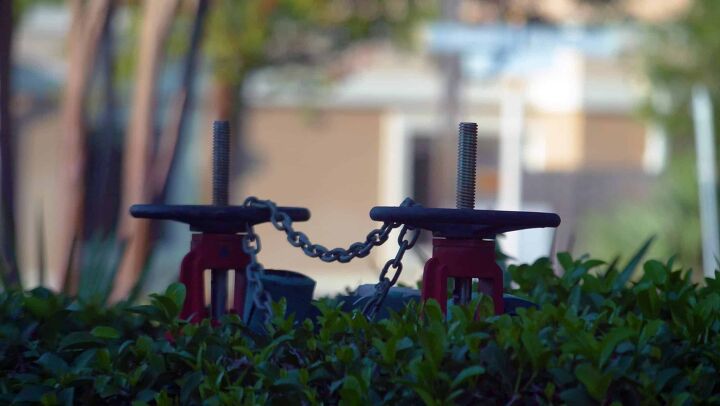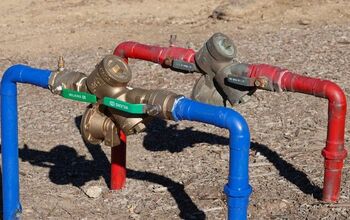Why Would a Backflow Preventer Be Leaking?

Backflow preventers are necessary because they prevent contamination and pollutants from entering your home’s water supply. The last thing that you need is for waste and pesticides to flow backward and contaminate your water. However, it can be just as frustrating and confusing if your backflow preventer leaks, so what causes it?
A backflow preventer can leak if the placement of the head assembly is off or if there is an increase in pressure. Debris in the system can cause a backflow preventer to slowly leak constantly. The relief valve on your backflow preventer can open if there is too much pressure and it can cause it to leak.
Make sure to shut off all of the valves before you work with a backflow preventer. Luckily, it is possible to fix a leaking backflow preventer if you troubleshoot it with 6 simple steps. Follow along as we explore what it means and what you should do when your backflow preventer leaks.
Do You Need to Hire a Plumber?
Get free, zero-commitment quotes from pro contractors near you.

What Causes Backflow?
Backflow can occur when the pressure changes within your pipes and causes water to flow in reverse. The pressure in your water tank can fall below the pressure in your home’s water line and cause backflow. Backflow can pose a serious health risk and taint the water supply in your home so that it isn’t safe to consume.
One of the most common causes of backflow is when there is a break in the main water line. Backflow can also commonly occur when the fire department uses a fire hydrant. In that case, backflow is a necessary evil, but you will still need to take care of it right away.
The main concern of backflow is that it can severely contaminate your water supply with human waste, pesticides, chlorine, and soap. Any form of waste that goes through your home’s water line can reenter if you experience backflow. That is why every homeowner should install a backflow prevention system to prevent such dangerous contamination.
Why is My Backflow Preventer Leaking?
Backflow preventers can leak for several reasons such as poor installation, high pressure, or debris. A backflow preventer cannot protect your water supply if it is leaking or damaged. The first thing that you should do is inspect the female connection on your backflow preventer when it leaks to look for worn parts.
Inspect the connection for a worn seal or damaged rubber and replace it so that the backflow prevent doesn’t leak. A poor connection can easily leak and you may need to replace the washer or grommet every 2-3 years or sooner. However, there are several reasons that a backflow preventer ca
High Pressure
High pressure in your irrigation system can cause backflow and it can also cause your backflow preventer to leak. The increase in pressure can cause the pressure relief valve on your backflow preventer to open. Water can leak and discharge from the pressure relief valve until the water pressure returns to the correct level.
Debris
Debris in the system can make water slowly leak from a backflow preventer. You can that debris is the problem if the leak continues constantly and never lets up. Debris can get stuck within the pressure relief valve and prevent it from closing properly.
Water will continually leak from the pressure relief valve if it cannot close all the way. Luckily, it is easy to remove debris from the pressure relief valve so that your backflow preventer can close again. If the leak persists, that means that there is debris lodged somewhere deep within the system or that there is another problem.
Head Assembly
The head assembly is a key part of your backflow preventer, and improper placement can cause it to leak. It is easy to install a head assembly incorrectly, and even simple mistakes can cause an increase in pressure. You must install the timer before you install the head assembly or else you risk improper placement and uneven pressure.
It is important to tighten the head assembly and surrounding parts by hand so that you don’t knock them loose or overtighten them. Otherwise, you risk changing the placement of the head assembly so that it is uneven. Uneven placement can cause water to leak out of the head assembly if you run a hose while the backflow preventer system isn’t turned on.
Troubleshooting Backflow Preventer
It’s important to understand that this device is not immune to leaking and it will occur from time to time. If your system is leaking, we recommend calling a professional plumber to fix the problem.
However, if you’ve discovered that some faulty components inside your backflow preventer are causing leaking, here are the steps that you can take to dissemble the device and troubleshoot the issue yourself
- First, shut all the valves to the backflow preventer.
- To isolate the backflow preventer, you’ll need to relieve some pressure. The plugs on the side can be removed and allow water to drain out.
- Take off the nut on top of the bell to completely remove it. Be careful not to strip it as it will need to be put back on when reassembled.
- At this point, slowly open the valve and notice how the water will start to fill up, overflow and pop up with the existence of more pressure.
- If you’re still experiencing leaking out of the side, this suggests that something is blocking the gasket or it’s damaged.
- Remove the poppet and bonnet by hand or by using a wrench and inspect the interior of the device.
Now that you’ve dissembled the backflow preventer whether it’s a broken gasket or other faulty component, you should have visibility to what exactly is causing the leaking problem.
Signs to Look For
Aside from the obvious leaking from your backflow preventer, there are other signs that the device may need repair. If your water is contaminated, it may appear as follows:
- Water flow may be interrupted or slow moving.
- It can be discolored, appearing either brown, yellow or even pink.
- The water has a bad Sulphur odor.
- Bad tasting water.
- The presence of visible sediment or rust particles in the water.
- Drains draining slowly.
- Simultaneously having increased water level in some drains and decreased water level in others.
Do You Need to Hire a Plumber?
Get free, zero-commitment quotes from pro contractors near you.

Backflow Preventer Failure
It’s important to have an experienced professional look at and test your backflow preventer for any signs of problems within the assembly. If left unchecked, the issues can impede the device’s ability to function and be potentially disastrous in the event of a nearby burst water main.
Here are some common problems that cause a backflow preventer to completely fail:
Relief valve opening point too high – In terms of PSI, different backflow preventers will be designed with varying minimum thresholds. If the relief valve disc isn’t embedding itself correctly, the opening point can become too high.
Relief valve opening point too low – This typically happens from something restricting movement into the relief valve stem mechanism.
Faulty first check valve – In a reduced pressure backflow preventer, the first check valve will open at particular water pressures. Typically, when the water pressure hits a minimum of 2.0 PSI, the valve will open. If it is faulty, it may open at lower pressures and impair the performance of the overall device.
Faulty second check valve – Testing a second check valve involves looking for signs of backpressure. If the valve has failed, water can leak past it and back into the area between the two check valves.
Related Guides

Jessica considers herself a home improvement and design enthusiast. She grew up surrounded by constant home improvement projects and owes most of what she knows to helping her dad renovate her childhood home. Being a Los Angeles resident, Jessica spends a lot of her time looking for her next DIY project and sharing her love for home design.
More by Jessica Stone











![The 10 Best Table Saws - [2022 Reviews & Buyer's Guide]](https://cdn-fastly.upgradedhome.com/media/2023/07/31/9070645/the-10-best-table-saws-2022-reviews-buyer-s-guide.jpg?size=350x220)

![10 Best Electric Lawn Mowers - [2022 Reviews & Top Rated Models]](https://cdn-fastly.upgradedhome.com/media/2023/07/31/9070486/10-best-electric-lawn-mowers-2022-reviews-top-rated-models.jpg?size=350x220)
![10 Best Electric Pressure Washers – [2022 Reviews & Guide]](https://cdn-fastly.upgradedhome.com/media/2023/07/31/9070600/10-best-electric-pressure-washers-2022-reviews-guide.jpg?size=350x220)












